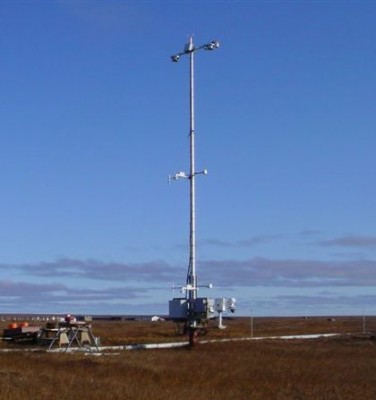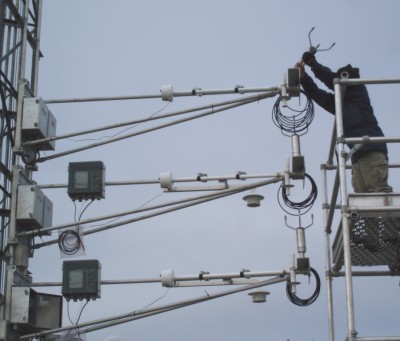Sensor Upgrades Improve Meteorological Systems at North Slope of Alaska Sites
Published: 30 September 2008

At the ARM North Slope of Alaska (NSA) sites, standard meteorological measurements such as wind speed, wind direction, air temperature, dew point, and humidity are obtained using conventional sensors mounted on 10- and 40-meter towers. Unfortunately, in freezing weather, ice develops on the wind vanes, cup anemometers, and aspirator inlets for the temperature and humidity sensors. To alleviate data quality issues associated with these conditions and to upgrade aging and failing parts, the NSA instrument mentor for this system traveled to Alaska in September to upgrade the tower sensors at both the Atqasuk and Barrow sites. Despite a few schedule delays in Barrow due to curious polar bears, the “met towers” at both sites are now sporting new ultrasonic sensors and heated probes that improve data delivery and require less maintenance.
Ultrasonic sensors measure the transmit time between three equally spaced “heads” to determine wind speed and direction. A test version of the stainless steel ultrasonic sensor with an integrated heater was installed in 2003 at the Barrow site and found to be very robust in removing ice. With no moving parts, the ultrasonic sensors do not require costly calibration and, unlike the older wind sensors, spares can be kept to a minimum. To validate sensor accuracy, local operators can make simple checks that verify the geometry of the heads and ensure that the sensors measure 0 meters per second when there are no winds.

Similarly, icing has been a persistent problem for the temperature and relative humidity (RH) probes at both Alaska sites. With demonstrated success in extremely cold conditions in Europe, Vaisala’s new HMT-337 sensor with heated RH probe is designed to operate in cold and high humidity environments. A separate temperature probe is combined with the HMT-337’s so the data that have been collected in the past continue. Both of these “smart” sensors include an onboard monitoring system and no longer require the iterative calibration at multiple points that previous sensors required. When needed, calibration can be carried out at the ARM Southern Great Plains site, reducing costs by leveraging the current capabilities within ARM.
In addition to the new sensors, dedicated power supplies for each boom were installed at the base of the Barrow tower. This upgrade will speed repairs by eliminating the need for the temperature to warm up to lower the booms, as was required in the past.
The ARM Climate Research Facility is a DOE Office of Science user facility. The ARM Facility is operated by nine DOE national laboratories, including .
Keep up with the Atmospheric Observer
Updates on ARM news, events, and opportunities delivered to your inbox
ARM User Profile
ARM welcomes users from all institutions and nations. A free ARM user account is needed to access ARM data.


















